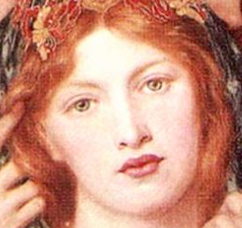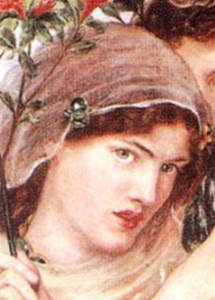“If there ever comes a time when the women of the world come together purely and simply for the benefit of mankind, it will be a force such as the world has never known.” Matthew Arnold

The image displayed above is a snapshot of a larger painting by Dante Gabriel Rossetti that illustrates a bride and her four bridesmaids. The painting is probably most famous for its exoticism, but for the purpose of this post I will be focusing on the two women above.
Throughout many of our texts, sisterly bonds prove to be very powerful and withstanding of all outside pressures and evils. Our first duo, Laura and Marian, are so intimate that Carolyn Dever writes, “the union of Laura and Marian is […] a union based on emotional depth, mutual trust, and the presumption of permanence” (114). In spite of Sir Percival’s plot to embezzle their family fortune and install Laura into an asylum in lieu of her phenotypical twin, the sisterly bond between these two half sisters maintains its resilience throughout the Woman in White.
More recently in the course we’ve been introduced to a new couple of sisters, Laura and Lizzie. In her poem “Goblin Market,” Christina G. Rossetti describes the two, “like two pigeons in one nest” and “two blossoms on one stem” (478, 6, 2-5). And in the face of “the haunted glen,/The wicked, quaint fruit merchant men” the women survive a near death. And in its sum, the last few lines of the poem praise the strength of sisterly bonds: “‘For there is no friend like a sister/In calm or stormy weather;/To cheer one on the tedious way,/ to fetch one if one goes astray,/To lift one if one totters down,/To strengthen whilst one stands’ (488, 26, 21-26).
If we return to the painting by Dante Gabriel Rossetti, the bride and her closest bridesmaid, most likely her sister, seem like a particularly potent pair. There is a clear sexual tension present and both the women make bold eye contact with the gaze of their audience, suggesting their fearlessness. But if you examine the two women separately:
their individual expressions maintain the innocence and purity of the ideal Victorian woman seen in many of the paintings by the Pre-Raphaelite artists.
And so it appears that the company of another woman or a group of women is what gives them their power. This is something that Matthew Arnold clearly understood and I think it is also an underlying fear, perhaps, of other Victorian authors and painters. For both pairs, Laura and Marian and Laura and Lizzie, possess a virtue, competence, and strength that suggests “a force such as the world has never known.”

